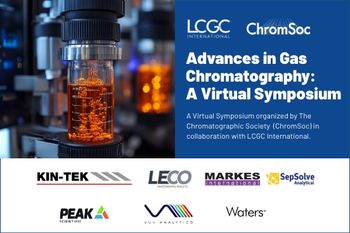
Q&A: Food Safety Testing
Michal Godula, Food Safety Specialist from Thermo Fisher Scientific answers questions on food safety testing.
Michal Godula, Food Safety Specialist for Thermo Fisher Scientific spoke to Janet Kelsey, Electronic Editor,
LCGC Europe
about the main aspects and challenges of food safety testing, how methods are typically developed and the role of mass spectrometry in residue analysis.
Can you explain what the main focus of your work is?
Godula: The Thermo Fisher Scientific Food Safety Programme was established to serve the important food safety and food quality analysis market. My role as a food safety specialist on the team is to support our customers with the most up-to-date methods and application knowledge, regulatory requirements and technical updates. An additional area of responsibility is management of the many scientific collaboration projects we have with key scientists in different areas of food safety and food quality. I also work closely with our marketing group to provide field information that helps in the development of our approach to the market.
What are the main aspects of food safety testing and what considerations need to be taken into account?
Godula:Food safety testing is a complex area representing many different tasks. The two main areas of interest are testing for microbial contamination and the analysis of food contaminants and additives. It is necessary to mention that the need for food safety testing is driven by several different stakeholders. There is a broad range of regulations defining various requirements, including specific maximum residue limits (MRLs) for a variety of contaminants such as pesticides, mycotoxins, veterinary drugs, biotoxins, dioxins, polychlorinated biphenyls, polycyclic aromatic hydrocarbons and others.
Though most people may take it for granted that their food is safe, these same people would say that they are concerned about the safety of their food. Most of the food producers around the world pay very special attention to delivering food that is safe and free of contaminants. Any specific food safety issue or scare will be quickly disseminated around the world and may lead to a significant loss of customer trust in the brand. In parallel, there is pressure from consumers on the price of the food delivered to the market, which inevitably leads the food producers to search for different ways to lower costs and increase their profit.
Driven by the melamine contamination events, there is a growing interest in methods designed to screen for adulteration. Recent cases of food adulteration with melamine can be discussed as an example of a food adulteration practice leading to a significant food safety crisis.
Food authenticity testing is also growing rapidly. Many companies, especially within Europe, are concerned about the delivery of foods that are characteristic of a specific region (such as wine, olive oils, honey etc.) and they request methods and techniques that allow them to quickly and confidently assess the origin of the raw materials or finished products.
What needs to be taken into consideration when food safety testing methods are developed?How are food safety testing methods typically developed?
Godula:If we focus on the food additives and contaminants area, method development procedures will vary depending on the type of the lab. Commercial contract lab requirements for method development may be quite different from an official control lab. However, in general, all labs have to optimize three main parameters of a method: performance, defined as detection limits, repeatability, recovery etc; speed or throughput and costs.
There is always the possibility to adopt a method that has already been published, either in scientific journals or as technical notes provided by companies. The methods provided by standardization organizations (e.g., European Committee for Standardization - CEN or AOAC International) typically provide high quality performance and data quality due to extensive method evaluation and interlaboratory validation that is performed prior to method publication. However, in many cases the method has to be modified according to the specific criteria. In all cases the method performance required by the customer has to be achieved, validated according to regulatory requirements and routinely delivered.
In a typical food analysis lab, there are two major bottlenecks with respect to method speed and lab throughput. The first is sample preparation, which typically involves extraction of the analytes from a matrix and the separation of potential interferences from the analytes. Such a procedure can take as much as 60% of the total time the sample is being analysed.
The second bottleneck is data processing and reporting. Due to a growing number of analytes (up to several hundred in some cases), the time that an analyst spends on data evaluation and report creation can reach up to 20–25% of the total time. In order to remove these bottlenecks, food labs are searching for new approaches to simplifying sample preparation, as evidenced by the popularity of the QuEChERS method used for pesticide residue analysis. Similarly, automated sample preparation techniques, based on selective approaches, are being adopted in many high-throughput labs.
Another good example of minimizing sample preparation is Thermo Scientific TurboFlow technology, which combines the advantages of size exclusion and solid-phase extraction together with a high degree of automation. This fully-automated on-line sample preparation approach is successfully used in the screening and quantification of different classes of veterinary drug residues in foods of animal origin such as milk, honey and fish.
With regard to data management, customers require data processing solutions that allow for fast, efficient, error-free data evaluation and that also easily interface with laboratory reporting systems. More attention is being paid to laboratory information management systems (LIMS) because a LIMS not only automates the laboratory workflow, but also integrates with lab instruments and other systems that may be in place. This integration and centralization of data in a LIMS allows for the creation of any number of customized reports for management and regulatory audit purposes, such as detailed traceability and tracking records from raw material to the finished product that isolates the source of a known contamination. Because the LIMS automates the process of managing samples and storing data, human error stemming from manual paper-based processes is eliminated, productivity is increased and the quality of the data is improved. A new approach to laboratory information management is Thermo Scientific LIMS-on- Demand, a fully functional LIMS that is subscription-based, hosted from a secure data centre and delivered via a web browser. With LIMS-onDemand lab personnel can focus on their core competencies without the additional responsibility of maintaining lab software and databases. This type of on-demand LIMS is going to become a critical asset to labs that do not have data management systems in place and who are at risk of being in non-compliance with regulations because they cannot produce documentation that demonstrates process or contamination control. Contract and small to medium sized labs will benefit from this type of hosted solution since they typically do not have the capital budgets or IT support to install large database software systems.
How useful is mass spectrometry in residue analysis?
Godula:The use of mass spectrometry in conjunction with either gas or liquid chromatography is an essential tool in almost all fields of food safety and quality. Whether we consider screening and quantification of target compounds such as pesticide residues, veterinary drug residues, mycotoxins or packaging contaminants, searching for unknown contaminants, adulterants or food authenticity testing, mass spectrometry plays a dominant role. Well-established techniques such as high or ultra high performance liquid or gas chromatography coupled to mass spectrometers are giving way to a growing trend towards full scan mass spectrometers delivering high mass accuracy and high resolution, based on orbital trapping (Thermo Scientific Orbitrap technology), or time-of–flight mass spectrometry.
The main advantage of these systems is their full scan mode operation, allowing not only reliable quantification but also the opportunity to perform a screening of a large number of “known” contaminants and additionally search for unknowns. This is accomplished through data evaluation using sophisticated processing software that allows for clean-up of the data to reveal low level components or alternatively, a comparison of an analysed (suspect) sample with a known (reference) sample to uncover differences in sample composition and to identify it.
Of course, in the case of such an approach the mass resolution and mass accuracy achieved by a mass spectrometer is an important parameter, especially in cases of screening of food samples with limited clean-up. The high resolving power of the mass spectrometer, ideally > 50,000 FWHM, is necessary to resolve matrix (food) components from the analytes. This high resolution also offers benefits for direct analysis of food samples without any separation, usually cited as ambient mass spectrometry.
Direct analysis in real time (DART) ion sources coupled to high resolution mass spectrometers (e.g., Orbitrap) enable quick and effective analysis of samples, providing either the quanification or identification of analytes or, more frequently, the mass spectrum (“fingerprint”) that is unique and can be used to determine the sample origin or the presence of an unknown contaminant.
Are there any obstacles that stand in the way of method development in food safety testing?
Godula:I would not classify the issues related to food analysis as obstacles but rather as challenges. Although current analytical technologies can provide powerful solutions, the analyst has to keep in mind the basic characteristics of the food sample and the sample preparation that will be required. In food samples, the matrices are variable and complex and separation of the analytes of interest from the food components is necessary for analysis. The number of analytes can be very high; for example, in the case of pesticides we have to look for several hundred compounds.
Analytes can also have very different physio chemical properties and behaviour. In some cases the situation is complicated by the analyte binding to the sample structure or losses incurred during sample preparation. In cases dealing with high toxicity contaminants such as aflatoxins or dioxins, the required detection limits of popular methods are very low, and method throughput has to meet customer requirements for efficiency.Those are all the main challenges and it is the analyst’s task to select the method that fulfils the requirements. Technological advances such as TurboFlow technology and LIMS systems enable improved efficiency and simplification of the method workflow to overcome bottlenecks and obstacles.
If you are interested in participating in a future Q&A please contact
Janet Kelsey
for more information.
Newsletter
Join the global community of analytical scientists who trust LCGC for insights on the latest techniques, trends, and expert solutions in chromatography.





